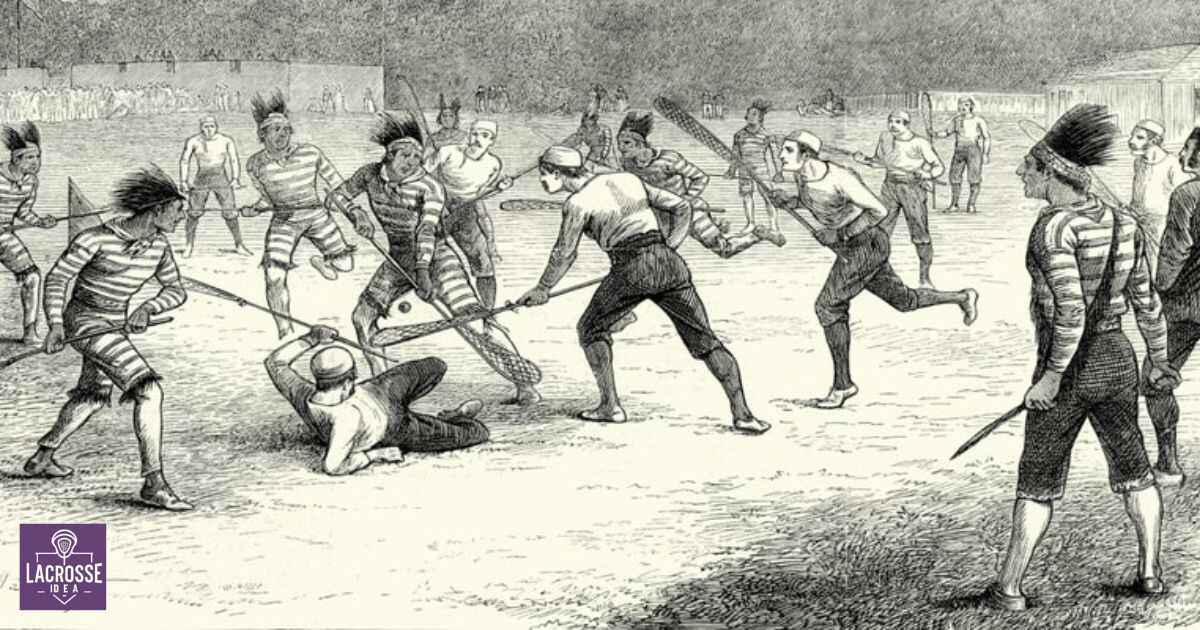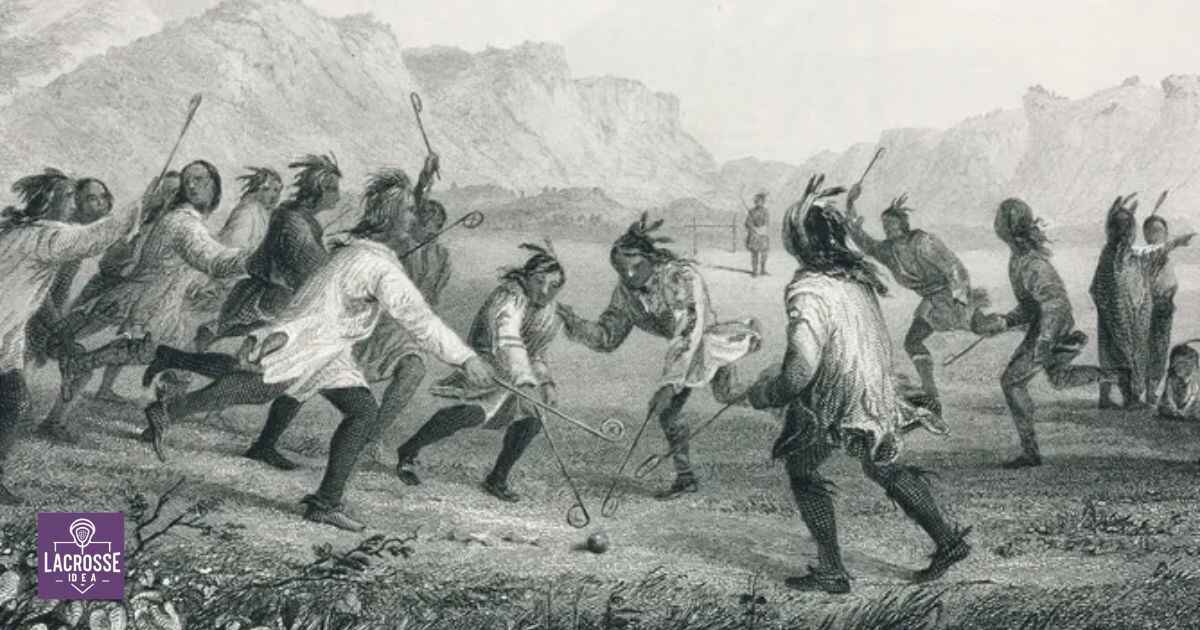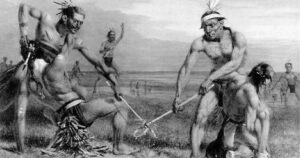In a world captivated by the allure of ancient sports, few can compare to the enigmatic origins of lacrosse. Like a mythical tale passed down through generations, the story of its invention beckons us to uncover the secrets of its birth. From the Native American tribes who first wielded the sticks with fierce determination to the modern era where it has become Canada’s national sport, lacrosse’s journey is one of cultural significance and unparalleled popularity. Join us as we delve into the captivating history of when lacrosse was first born.
Key Takeaways
- Lacrosse, known as ‘baggataway’ or ‘tewaarathon’, originated among Native American tribes and has deep cultural significance.
- The sport reflects values of teamwork, respect, and harmony with nature and is played by tribes across North America, with women also playing a variant called ‘eweeweewa’.
- Lacrosse has spiritual and symbolic aspects, representing a connection to the Divine, cultural identity preservation, social cohesion, and peaceful resolution.
- The game has evolved over time, gaining popularity among European settlers, leading to its modernization, international recognition, and spread transcending cultural boundaries.
Native American Origins
The Native American origins of lacrosse can be traced back centuries, showcasing the rich history and cultural significance of the sport. Lacrosse, known as “baggataway” or “tewaarathon” among Native American tribes, was more than just a game; it was a sacred ritual that fostered community, spiritual connection, and physical prowess. Played by tribes across North America, lacrosse served as a means of resolving conflicts, preparing for war, and honoring the Great Spirit.
The game was not limited to men; women also played a variant called “eweeweewa.” Lacrosse was deeply ingrained in Native American society, reflecting their values of teamwork, respect, and harmony with nature. Today, lacrosse continues to honor its Native American roots, serving as a bridge between cultures and reminding us of the enduring legacy of indigenous peoples.
Early Lacrosse Games
Early lacrosse games showcased the evolution and diverse styles of play in the sport. As the sport spread throughout different Native American tribes, variations in rules and techniques emerged, reflecting the cultural and geographical differences among the communities. Some tribes played lacrosse on large open fields, while others preferred confined spaces or even used trees as goalposts. The game was not only a physical contest but also held deep cultural and spiritual significance for the players and their communities.
Each tribe had its own unique set of rules and rituals associated with the game, further emphasizing the importance of lacrosse as a communal activity. These early lacrosse games not only provided entertainment but also fostered a sense of identity and belonging among the players, reinforcing their connection to their cultural heritage.
Significance Of Lacrosse Games
Throughout history, lacrosse games have held immense cultural and spiritual significance for the communities that played them. The game of lacrosse was not merely a sport but a ritual that brought people together, fostering a sense of belonging and unity. Here are three reasons why lacrosse games were so significant:
- Connection to the Divine: Lacrosse was often seen as a sacred game, believed to have been given to the people by the Creator. It was played as a form of prayer, honoring the spirits and seeking their guidance and blessings.
- Cultural Identity: Lacrosse was deeply ingrained in the cultural fabric of many indigenous communities. It served as a means of preserving traditions, passing down knowledge, and teaching important values such as teamwork, respect, and perseverance.
- Social Cohesion: Lacrosse games provided a platform for community members to come together, celebrate, and strengthen social bonds. It was a way for tribes and nations to interact, compete, and resolve conflicts peacefully, fostering peace and harmony among different groups.
The significance of lacrosse games goes beyond mere entertainment; it represents a rich heritage and a way of life for the communities that played it.
The Coined Name: Lacrosse
Lacrosse, a widely recognized and beloved sport today, derived its name from a French term meaning ‘the crosier’ or ‘the shepherd’s staff.’ This term was coined due to the resemblance of the lacrosse stick to a shepherd’s staff. The name perfectly captures the essence of the sport, as it symbolizes the players’ role as shepherds of the game, guiding and maneuvering the ball towards their goal.
Lacrosse has a rich history that spans centuries, originating from Indigenous communities in North America. The name ‘lacrosse’ not only reflects the cultural significance of the sport but also serves as a reminder of its origins and the deep-rooted traditions associated with it. Today, lacrosse continues to bring people together, fostering a sense of belonging and community among its players and fans.
Canada’s National Sport
Originating from Indigenous communities in North America, lacrosse has a deep-rooted history that eventually led to it becoming Canada’s national sport. Lacrosse holds a significant place in Canadian culture, fostering a sense of belonging and national identity. Here are three reasons why lacrosse is Canada’s national sport:
- Historical significance: Lacrosse has been played in Canada for centuries, with evidence of the game being played by Indigenous peoples long before European colonization. It is considered a vital part of Canada’s heritage and a symbol of the country’s rich history.
- Popularity and participation: Lacrosse enjoys widespread popularity across Canada, with numerous leagues, clubs, and competitions dedicated to the sport. It is played by people of all ages and backgrounds, further contributing to its status as a national sport.
- International success: Canadian lacrosse teams have achieved remarkable success on the international stage, winning multiple World Championships. These victories have not only showcased Canada’s prowess in the sport but also solidified lacrosse’s position as a national sport that represents the country’s athletic excellence.
Ageless Game
With a rich history spanning centuries, lacrosse has proven to be an ageless game that continues to captivate players and fans alike. From its origins as a sacred ritual among Native American tribes to its modern-day status as a popular sport played at all levels, lacrosse has transcended time and cultural boundaries. Its enduring appeal lies in its ability to foster a sense of belonging among its participants, creating a tight-knit community of players and enthusiasts who share a deep passion for the sport.
Whether played on a professional field or in a neighborhood park, lacrosse brings people together, promoting camaraderie, teamwork, and a love for the game. As the sport continues to evolve and adapt, it remains a timeless symbol of unity, resilience, and the enduring power of human connection.
From The Sky World
The origins of lacrosse can be traced back to ancient times, specifically in the subtopic of ‘From the Sky World’. According to Haudenosaunee (Iroquois) legend, lacrosse was a gift from the Creator. Here are three key aspects of the game’s origin story:
- Divine Inspiration: The Haudenosaunee people believe that lacrosse was given to them by the Creator as a way to bring healing and unity to the world. It was played in the Sky World before being brought to Earth.
- Spiritual Significance: Lacrosse was not just a game for the Haudenosaunee; it had deep spiritual meaning. It was seen as a way to honor the Creator and connect with the spiritual realm.
- Ceremonial Rituals: Lacrosse matches were often accompanied by elaborate ceremonies and rituals. These rituals were meant to invoke the Creator’s blessings and ensure fair play.
From the Sky World, lacrosse evolved into a team sport that played a central role in Haudenosaunee culture and identity.
Evolution Into Team Sport
Lacrosse underwent a transformative process, evolving into a team sport that played a crucial role in Haudenosaunee culture and identity. As the game developed, it became more structured and organized, with defined rules and team strategies. The Haudenosaunee people embraced the concept of teamwork and collaboration, recognizing the power of collective effort in achieving their goals. Lacrosse matches became a way for communities to come together, fostering a sense of belonging and unity.
Through the sport, individuals learned to work together, communicate effectively, and trust their teammates. The evolution of lacrosse into a team sport not only strengthened the bonds within Haudenosaunee communities but also conveyed important cultural values, such as respect, cooperation, and perseverance. Today, lacrosse continues to be a significant part of Haudenosaunee heritage, connecting past traditions with the present generation and ensuring cultural continuity.
Heart Of The Game
The passion and dedication of players reveal the true essence of the game. Lacrosse, with its rich history and vibrant culture, has captured the hearts of millions worldwide. Here are three reasons why lacrosse is considered the heart of the game:
- Camaraderie: Lacrosse fosters a strong sense of belonging and unity among players. The sport encourages teamwork and cooperation, creating deep bonds that extend beyond the field.
- Tradition: Lacrosse is deeply rooted in Native American culture, where it was played as a sacred game. Its traditions and rituals continue to be honored today, connecting players to their heritage and creating a sense of pride.
- Resilience: Lacrosse demands physical strength, mental toughness, and unwavering determination. Players face numerous challenges on the field, pushing their limits and showcasing their indomitable spirit.
In the heart of lacrosse lies a community built on camaraderie, tradition, and resilience. It is this enduring spirit that captivates players and fans alike, making lacrosse a truly remarkable and beloved game.
Exploring The History
One significant milestone in the history of lacrosse is the emergence of the sport in ancient times. Lacrosse traces its roots back to indigenous cultures in North America, particularly among Native American tribes such as the Iroquois and the Algonquin. These tribes played lacrosse as a way to strengthen community bonds, settle disputes, and prepare for battle. The game was seen as a sacred ritual and was often accompanied by spiritual ceremonies.
Over time, lacrosse spread throughout the continent, with different tribes developing their own variations of the game. The sport’s popularity continued to grow, and it eventually caught the attention of European settlers, who then played a role in its modernization and spread to other parts of the world. Today, lacrosse stands as a symbol of cultural heritage and a connection to the sport’s ancient origins.
Cultural Significance
With its deep roots in indigenous cultures, lacrosse holds immense cultural significance. This traditional Native American sport has evolved over centuries and continues to be an integral part of many communities. Here are three reasons why lacrosse holds such importance in various cultures:
- Spiritual Connection: Lacrosse is often seen as more than just a game. It is a spiritual practice that connects players with their ancestors and the natural world. The game is often used in healing ceremonies and as a way to honor and connect with the divine.
- Community Bonding: Lacrosse brings people together, fostering a sense of belonging and unity within communities. It is not just about competition but also about building relationships, strengthening social ties, and promoting teamwork.
- Cultural Preservation: Lacrosse is a powerful tool for preserving cultural traditions and passing them on to future generations. By playing this ancient sport, communities can keep their cultural heritage alive and ensure that their customs and values continue to thrive.
Oldest Sport In America
Dating back centuries, lacrosse holds the distinction of being the oldest sport in America. With its origins deeply rooted in Native American culture, lacrosse has played a significant role in the history and identity of indigenous communities. The game was more than just a sport; it was a spiritual and ceremonial practice that fostered unity and strength among tribes. Lacrosse, known as “the Creator’s game,” symbolized much more than competition; it represented the connection between the physical and spiritual realms.
Today, lacrosse continues to thrive as a beloved sport, with a growing number of participants and fans across the country. Its rich history and cultural significance make it a cherished symbol of American heritage. As we explore the invention and evolution of lacrosse, we delve into the fascinating journey of this ancient game’s transformation over time.
Invention And Evolution
Lacrosse’s invention and evolution can be traced back to ancient Native American cultures. This fascinating sport has a rich history that spans centuries and has evolved over time. Here are three key points that highlight the invention and evolution of lacrosse:
- Origins in Native American culture: Lacrosse originated as a sacred game played by Native American tribes for various purposes, including healing, spiritual rituals, and resolving conflicts.
- Influence of European settlers: The game started to gain attention and evolve when European settlers witnessed Native Americans playing lacrosse. They were captivated by its intensity and skill, leading to the spread of the sport beyond tribal boundaries.
- Modernization and globalization: Lacrosse underwent significant changes as it was adopted by different cultures and societies. Rules were standardized, equipment was modified, and the sport gained international recognition, becoming one of the fastest-growing sports globally.
With its deep roots and continuous evolution, lacrosse has become a sport that transcends cultural boundaries and unites people from around the world. Now, let’s explore how lacrosse’s popularity and spread have grown over time.
Lacrosse’s Popularity And Spread
The global popularity and widespread adoption of lacrosse have steadily increased over the years as the sport has continued to evolve and captivate athletes and enthusiasts alike. Lacrosse, once primarily played in Native American communities, has now gained recognition and following worldwide. Its unique blend of athleticism, strategy, and teamwork has attracted players from diverse backgrounds, contributing to its growing popularity.
Lacrosse’s appeal lies in its ability to foster a sense of belonging and camaraderie among its participants, creating a tight-knit community of players and fans. The sport’s inclusivity and emphasis on fair play have also contributed to its spread, as organizations and leagues have worked to make lacrosse accessible to a wider audience. As lacrosse continues to gain traction globally, its popularity shows no signs of slowing down, solidifying its place as a beloved sport for athletes and enthusiasts alike.
Frequently Asked Questions
What Are the Rules and Regulations of Modern-Day Lacrosse?
The rules and regulations of modern-day lacrosse govern the gameplay, player conduct, and equipment requirements. These guidelines ensure fair play, safety, and sportsmanship, contributing to the overall integrity and enjoyment of the sport.
What Are the Different Types of Lacrosse Equipment Used in the Game?
Lacrosse equipment includes a stick, helmet, gloves, shoulder pads, and cleats. Each piece plays a crucial role in the game, ensuring player safety and enhancing performance. The evolution of equipment has allowed for a more dynamic and thrilling lacrosse experience.
How Has the Playing Field and the Size of the Lacrosse Stick Evolved Over Time?
The playing field and the size of the lacrosse stick have evolved over time to accommodate the changing dynamics of the game. These changes have been driven by factors such as player safety, game strategy, and advancements in equipment technology.
What Are the Key Differences Between Traditional Native American Lacrosse and the Modern Version of the Game?
The key differences between traditional Native American lacrosse and the modern version of the game lie in their cultural significance, equipment, and rules. Native American lacrosse was deeply rooted in spirituality and warfare, while the modern game is more structured and regulated.
How Did Lacrosse Spread From Native American Tribes to Other Parts of the World?
Lacrosse spread from Native American tribes to other parts of the world through various means, including colonization, exploration, and cultural exchange. The game’s appeal, unique characteristics, and its ability to foster community and competition contributed to its global dissemination.
Conclusion
In conclusion, lacrosse has a rich history that dates back to Native American origins. It has evolved and spread over time, becoming Canada’s national sport and the oldest sport in America. Lacrosse’s cultural significance and popularity highlight its importance in society. Like a vibrant tapestry woven with ancient threads, lacrosse stands as a testament to the enduring spirit and legacy of a game that has captivated generations.









